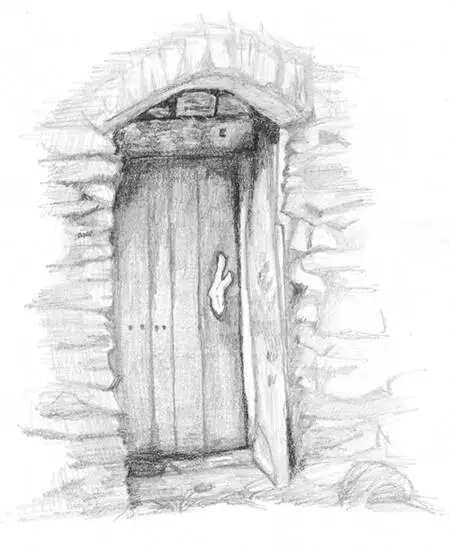
WE CONVENE TO eat in an old early twentieth-century cook’s barge used by lumber companies to feed their crews as they ravaged the northern old-growth trees and floated the logs down to the sawmills. Ober had this cook’s barge hauled onto his island. An old bell signals meals. Original plates and dishes of every charm — Depression glass, milk glass, porcelains, and sweet old flowery unmatched Royal Doulton china dishes — crowd the open shelves. A cabin just out front of the cook’s barge, hauled here too, was once a floating whorehouse, I am told. Now it houses a piano, and three neat beds. A child has written a sign, tacked to its wall, that advises visitors not to be alarmed if they see things they are unprepared to see — like spirits. There is supposed to be a spirit family that inhabits this island.
I’ll tell you right off, I don’t see hide nor hair of the spirits. But I can’t speak for Kiizhikok, with her still open fontanel. They might be talking to her. Or singing her to sleep. Because she sleeps on this island, takes naps of an unprecedented length and then tumbles into sleep beside me as I read long into the night. There is a fever that overcomes a book-lover who has limited time to spend on Ober’s island. A fever to read. Or at least to open the books. There is no question of finishing or even delving deeply. I have only days. Among the books, I feel what is almost a low swell of grief, a panic.
Once the baby is asleep I vault to Ober’s shelves. I first wash and dry my hands — I just have to. Really, I suppose I should be wearing gloves. Then with a kind of bingeing greed I start, taking one book off the shelf, sucking what I can of it in, replacing it. This goes on for as many hours as I can stand. G. K. Chesterton on William Blake. Ben Jonson’s Works in Four Volumes , Oxford University, 1811. Where The Blue Begins by Christopher Morley, illustrated by Arthur Rackham, first edition and first printing. An 1851 copy of The House of the Seven Gables . And The Voyages of Peter Esprit Radisson, Being an Account of His Travels and Experiences Among the North American Indians . A wonderful volume, more recent than most, published in 1943 and transcribed from original manuscripts in the British Museum. I keep reading this last book until, late at night, the loons in full cry, my mosquito coil threading citronella smoke, I have to quit. Knowing that I must be alert enough tomorrow to feed Kiizhikok and take the stones from her mouth, I force myself to sleep. But as I drift away with her foot in my hand I am led to picture an alternate life.
In my imagined life, there is an enchanted interlude. All children are given a year off from school to do nothing but read (I don’t know if they’d actually like this, but in my fantasy my daughters are exquisitely happy). We come to this island. One year is given to me, also, to read. I am not allowed to write. I am forced to do nothing but absorb Oberholtzer’s books. Every day, I pluck down stacks of books from the shelves upon shelves tacked up on every wall and level of each of the seven cabins on Ober’s island. Slowly, I go through the stacks, reading here and there until I find the book of which I must read every word. Then I do read every word, beneath a very bright lamp. When my brain is stuffed my daughters and I go swimming, play poker, or eat. Life consists of nothing else.
Ober and Moose
I find some lovely photographs of moose among the archives — Oberholtzer took them. Tracking down, sneaking up on, and photographing moose was a big passion with him. His guide, companion, and mentor, Billy Magee or Taytahpaswaywitong, thought Ober just a little strange, but went along with it, bringing him to within feet of some of the shiest and orneriest creatures of the lake. The photographs that resulted were the first such ever taken of the animal, and Oberholtzer became known as a great expert. Keeper of the Wild makes use of notes that Ober took on those photography trips. I think, of course, of the three young female moose we saw in Lake of the Woods, those awkward young beauties cavorting in the reeds, and so innocent about our approach. Ober wrote beautifully about a similarly trusting young bull:
Inch by inch, scarcely moving, Billy propelled the canoe forward, while I knelt in the bow, camera in hand. The sun was fiercely hot, there was only a breath of breeze. The little bull several times raised his head to gaze at us wonderingly; and each time Billy stopped paddling. Thus, during the moments when the moose’s head was submerged, we advanced till we were only twenty feet away. The bull edged off a foot or so, turned his back, and suddenly faced around again, whined ever so slightly like a dog and at last, after a moment’s reflection, dipped his head under water. I was itching to take his picture, but I noticed something remarkable. Instead of immersing his head completely, as is the custom of the moose when feeding, he left half his long ears protruding. He was listening ; and I was afraid that, if I clicked the shutter, he would scamper away. When he raised his head again, however, I decided to chance it. I clicked. He flinched, moved away a step again and then resumed his feeding. He seemed completely reassured, for I noticed now that even the tips of his ears were under water. We were still gliding nearer. I took another picture, a third, one after another. At last, lo and behold, the little fellow got down on his knees on the river bottom, and for a second or so his body was wholly lost to sight. His head came up first, with ears pricked. He shook it and the ears flapped drolly against his cheeks. When he rose, he looked at us inquiringly, almost mischievously, with his languid brown eyes. His shaggy winter coat was still clinging in patches to his hindquarters…. To my great surprise he calmly stepped toward us and sniffed with his long snout; and I could have touched him with the paddle. But Billy, always cautious and respectful toward a moose, backed the canoe a few strokes. Thus for fifteen minutes we played with this strange neighbor.
Feasting
The blueberries, miinan , have ripened on the island. The first thing Kiizhikok does the next morning is crouch low to the berry bushes and stuff herself with miinan. I show her how. This is the one traditional Ojibwe pursuit I’m good at. Now, before Kiizhikok picks and eats all of the blueberries, it is time to feast the first ripening. Rose Tainter, a traditional elder from Lac Court Oreilles, prays in Ojibwemowin, with her sacred pipe, at breakfast. We have a huge bowl of blueberries. A spirit dish is prepared. The dish is made up of small portions of the food we’ll eat, with tobacco set alongside the portions. The spirit dish is either left outside for the spirits or burned as an offering. This is the way the Ojibwe have always given thanks for the first berries of the year. After Rose has finished praying and the spirit dish is set outside, we eat. We eat seriously. We eat with attention. We eat with a lot of laughing.

It seems to me that Ojibwe people always eat with happy grace. Food is part of every gathering and ceremony. Even our weekly meetings to learn the language are based around a potluck dinner, mainly centered around casseroles heavy on wild rice. Today on Ober’s island, breakfast consists of pancakes and Ojibwe maple syrup, scrambled eggs, fresh walleye breaded and fried, a hash of potatoes and crisp turnips, and a big bowl of blueberries. There is also lots more fruit on the side, coffee, and black tea. We’ll have a big lunch just a couple hours after the breakfast dishes are cleared and washed. And then dinner, which might involve venison sausage, more walleye, boiled cabbage and potatoes, or if we are lucky enough to see Nancy Jones, whatever she has hunted might appear.
Читать дальше














